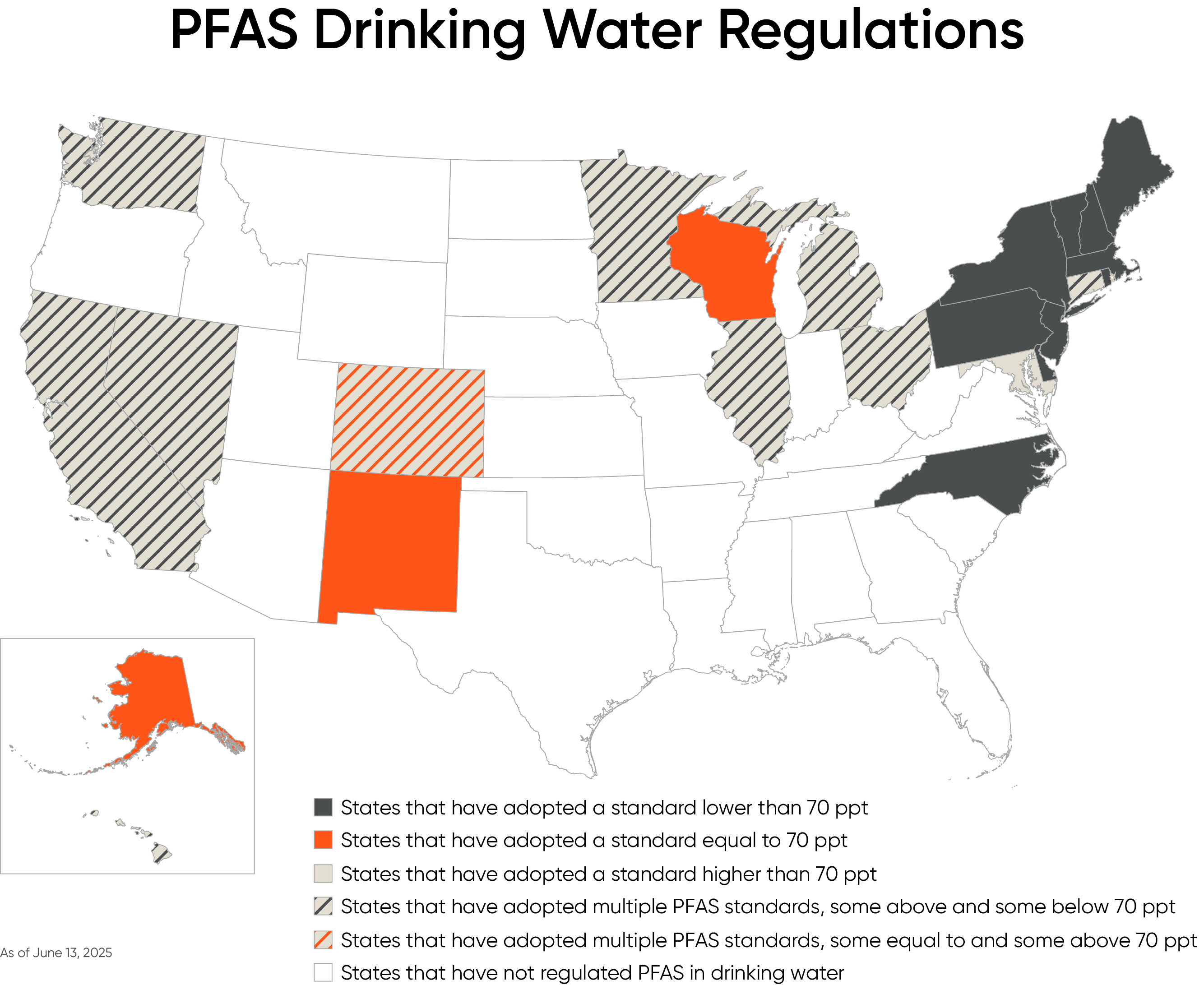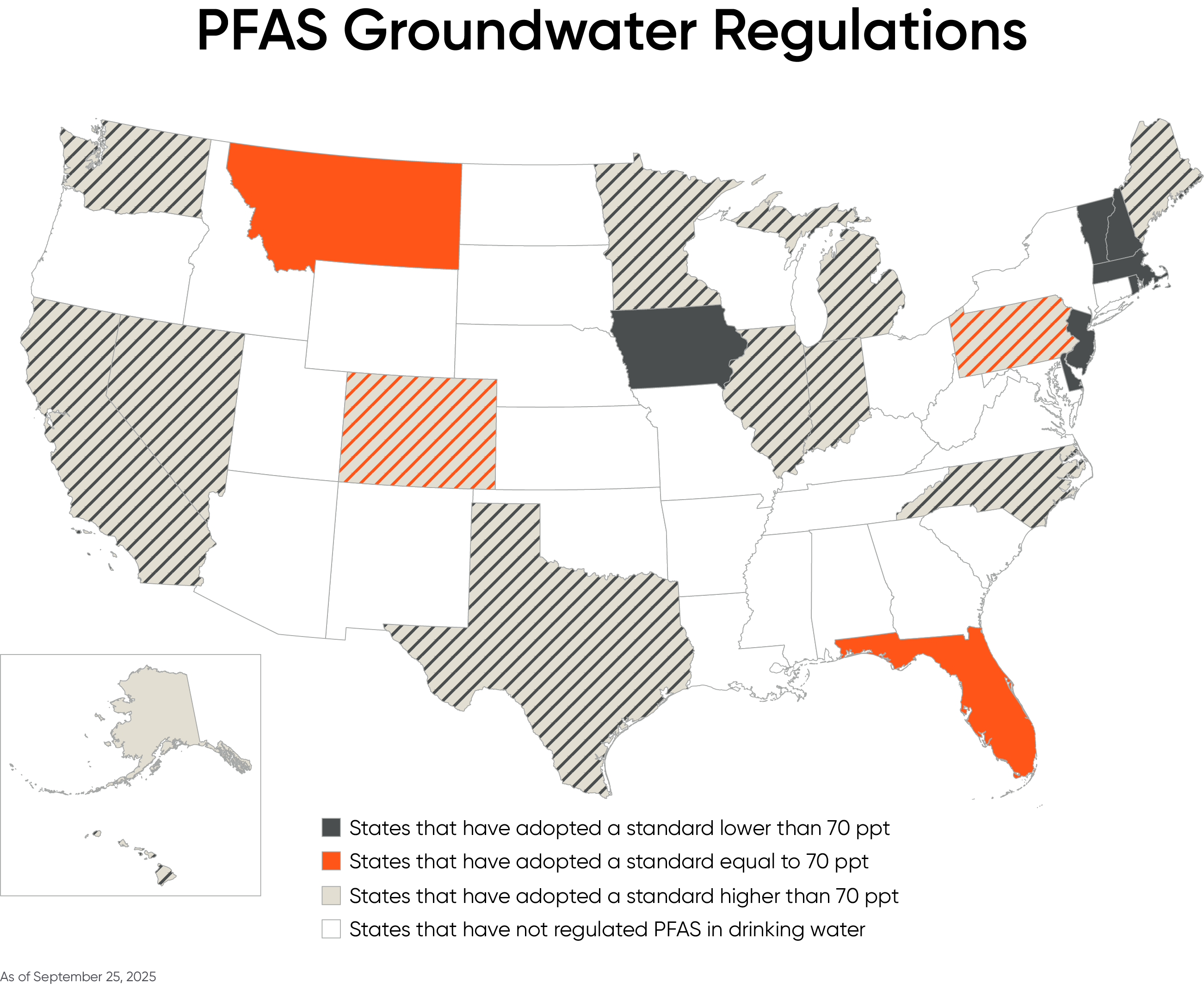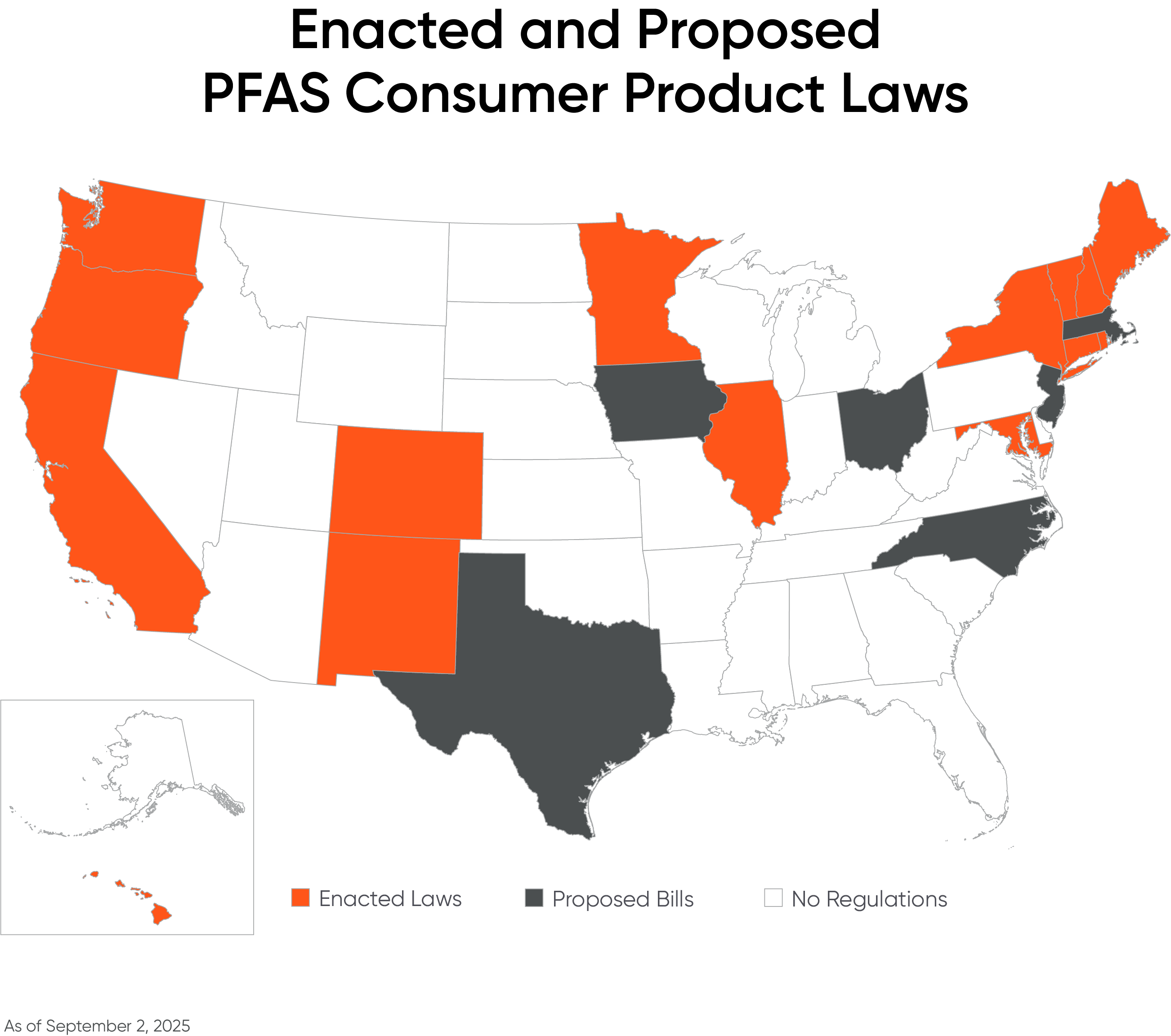PFAS
Overview
Per- and polyfluoroalkyl substances (“PFAS”) are a family of over 8,000-10,000 fluorinated chemicals that have been used since the 1940’s across a variety of industries as part of manufacturing processes, and as components of consumer products. According to the United States Environmental Protection Agency (“USEPA”), PFAS are found in:
- Food packaged in PFAS-containing materials, processed with equipment that used PFAS, or grown in PFAS-contaminated soil or water.
- Commercial household products, including stain- and water-repellent fabrics, nonstick products (e.g., Teflon), polishes, waxes, paints, cleaning products, and fire-fighting foams (a major source of groundwater contamination at airports and military bases where firefighting training occurs).
- Workplace, including production facilities or industries (e.g., chrome plating, electronics manufacturing or oil recovery) that use PFAS.
- Drinking water, typically localized and associated with a specific facility (e.g., manufacturer, landfill, wastewater treatment plant, firefighter training facility).
- Living organisms, including fish, animals and humans, where PFAS have the ability to build up and persist over time.
The regulatory and litigation risks posed by PFAS chemicals are evolving and significant. Various groups are working on new technologies to more effectively and efficiently remediate PFAS in the environment.
PFAS are receiving quite a bit of media attention, including a movie called “Dark Waters” (released in November 2019), which focused on PFAS and claims by townspeople against a PFAS manufacturer. As a result, the regulation and litigation surrounding PFAS accelerated.
PFAS risks arise in a variety of different contexts, including the following:
- Manufacturing – Companies that manufacture PFAS chemicals, or use them as part of the manufacturing process or as an ingredient in products have been sued by both government agencies and private parties. So far the suits have included personal injury claims, statutory violations, and efforts to recover the cost of remedial or filtration equipment installed to address the presence of PFAS compounds. The potential risk in these cases can be significant, with settlements reaching as high as $850 million.
- Due Diligence – Until recently, there was little attention paid to PFAS contamination during transactional due diligence. Recent state and federal regulations have made it clear that these chemicals will be the subject of investigation and remedial actions in the future. Given the significant costs associated with remediating these chemicals because they do not break down naturally in the environment, companies should consider their potential presence during due diligence in both real estate and corporate transactions.
- Consumer Products – Manufacturing, purchasing, or selling consumer products that contain PFAS may lead to product liability and toxic tort litigation, as well as resulting in discharges to soil, groundwater, and possibly drinking water from manufacturing operations.
- Cleanup Obligations – USEPA and states are evaluating PFAS contamination at legacy clean-up sites such as landfills. The re-opening of these closed sites will lead to more liability for entities that were potentially responsible parties (“PRPs”) at those sites. While this is currently being achieved through state regulations, the USEPA has announced plans to identify two PFAS chemicals, PFOA and PFOS, as hazardous substances under CERCLA. This could upend CERCLA settlements (which are typically tied to the contaminants previously identified), and lead to PRP litigation.
- Permit Compliance – New regulations are expected to result in facility-specific discharge limits for both air and wastewater.
There is significant disagreement about the scientific basis for the health concerns regarding PFAS, but complete agreement on one thing: the historic and ongoing use of these chemicals presents material regulatory and litigation risks, and is something that members of a wide range of industries will be forced to address over the next several years, if not decades.
BCLP’s PFAS Team
BCLP's Environmental team has members who are dedicated to assessing and mitigating the risks posed by PFAS in the transactional context, managing client exposure in PFAS cleanups, and defending product liability and toxic tort suits involving PFAS. The following are a few examples of our PFAS work to date:
- Helping clients evaluate the PFAS cleanup risk based on historic operations across their real estate portfolios, including the possibility of re-opening of closed and ongoing cleanups.
- Defending a client in several ongoing lawsuits based on the alleged presence of PFAS in drinking water systems in Georgia and Alabama.
- Analyzing the potential PFAS risk posed by target properties and/or business units during the real estate or M&A due diligence process.
- Counseling clients on the Proposition 65 enforcement risks posed by their product inventory based on the listing of PFOA and PFOS, including developing a product testing regime and exposure assessment.
- Counseling clients on potential Proposition 65 liability as a result of their discharge of PFOA and PFOS in their industrial wastewater.
- Advising clients on developing PFAS regulations in groundwater, drinking water, consumer products, and draft public comments when appropriate.
Members of our PFAS team are located in St. Louis, Chicago, Phoenix, Denver, Atlanta, and New York. Each of these members handles matters across the United States. We work with environmental consultants and public relations firms that also focus on PFAS. If you have a question about how to manage your PFAS risk, contact Erin Brooks, Christian Bromley, Bryan Keyt, John Kindschuh, or any other member of our PFAS team.
What Are PFAS Chemicals And Where Are They Found?
PFAS are defined by having elemental bonds of fluorine and carbon, rendering them extremely pervasive and persistent (which means that they do not break down easily either in the environment or after uptake in living organisms). PFAS chemicals can repel both water and oil and move quickly through water, and PFAS have been detected in surface water, groundwater, drinking water, soil, and consumer products. PFAS chemicals have also been detected in various living organisms, including in the blood stream of almost every American tested, and even polar bears.
Enforcement actions and lawsuits have so far focused on the companies that have manufactured the two most widely used, and now most heavily regulated, PFAS compounds, PFOA and PFOS.
PFOA and PFOS were the subject of a USEPA Stewardship Program, in which the relevant companies agreed to stop manufacturing these two chemicals in the United States, to eliminate importing them, and to restrict using them in certain products. However, some countries continue to manufacture PFOA and PFOS (Russia, India, and China), and use them in products that are imported to the United States. In addition, studies have demonstrated that some of the PFAS compounds used to replace PFOA and PFOS breakdown and form PFOA and PFOS over time.
Several states are investigating the impact these chemicals have had on human health and the environment. In addition, many states have started regulating the presence of these chemicals in consumer products. For example, California has added PFOA and PFOS to the list of chemicals regulated under its Proposition 65 consumer product regulations, so enforcement is anticipated under that law as well.
What Are The Current Regulations?
The regulation of PFAS chemicals is rapidly developing on both the state and the federal levels. In October of 2021, the Biden Administration launched the PFAS Strategic Roadmap. See PFAS Strategic Roadmap regarding this topic. Numerous states are developing their own standards, creating a patchwork regulatory landscape. The following PFAS chemicals have been the focus of most of the regulatory attention to date: PFOA, PFOS, PFNA, GenX (also known as HPFO – DA), PFBS, PFHpA, and PFHxS.
Drinking Water Regulation
In 2016, EPA revised its drinking water Health Advisory (“HA”) level for the combined concentration of PFOA and PFOS to 70 ppt. While not an enforceable drinking water standard, this HA level has essentially been used as a screening level for public drinking water supplies.
In the meantime, states have started regulating the concentration of various PFAS chemicals in drinking water:

For a more detailed discussion of the state-by-state regulation of PFAS in drinking water please see our guide, PFAS drinking water standards: state-by-state regulations.
Groundwater Regulation
Businesses should consider whether they currently use or discharge any PFAS compounds which may reach groundwater and evaluate if any state regulations apply, particularly if they operate in any of the below-listed jurisdictions. In addition, owners of property with legacy PFAS use, and prospective purchasers of commercial and industrial properties, should review the most current groundwater quality standards as part of the due diligence process.
For a more detailed discussion of the state-by-state regulation of PFAS in groundwater please see our guide, PFAS in groundwater: state-by-state regulations.

Consumer Products
Once again, states have proceeded independently, and have implemented a wide variety of consumer product regulations:

Because PFAS chemicals have been detected in such a wide variety of products, it should come as no surprise that the regulations of consumer products have taken many different forms. For an analysis of the different types of state consumer product regulations relating to PFAS, we encourage you to review our guide, PFAS in consumer products: state-by-state regulations.
What you can do
For more information on a variety of PFAS-related topics please take a look our recent insights and subscribe for PFAS topic updates. We also encourage you to look through the biographies of our team members and reach out to any of us to discuss any questions that you might have about the impact of these chemicals on your business.
Meet The Team
Related Insights
Dec 19, 2025
Dec 18, 2025
Nov 13, 2025
Nov 13, 2025
Sep 26, 2025
Sep 25, 2025
Sep 02, 2025
Aug 28, 2025
Jul 25, 2025




